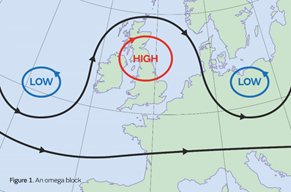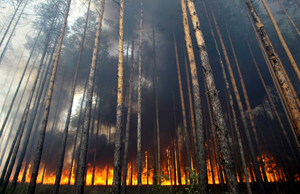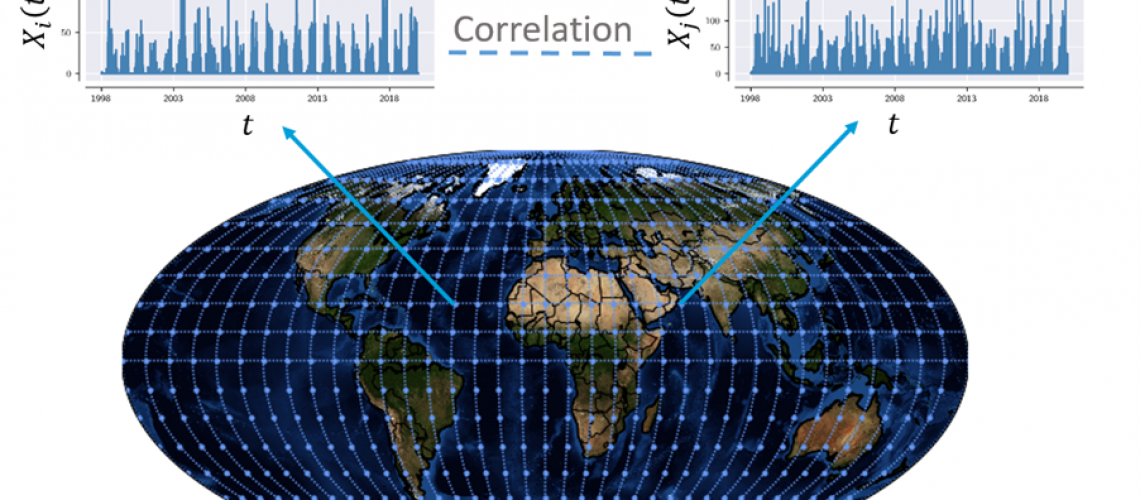The network behind weather and climate
Shraddha Gupta | Potsdam Institute for Climate Impact Research (PIK)
Noémie Ehstand | Institute for Cross Disciplinary Physics and Complex Systems, IFISC (UIB-CSIC)
___________________________________________________________________________________________
What is common about an epidemic, a forest fire and the mobile game Chain Reaction is how the condition of one element influences the other surrounding elements which were in contact with it in some form. Computer science has a popular algorithm named the burning tree algorithm to track this kind of spread. However, as a system becomes more complex in both the way each subsystem behaves on its own and how they interact among each other, this spread of information becomes difficult to track. A common perspective towards understanding many such real-world complex systems, like the internet, ecological, social, and biological systems, and even the human brain, is to model them as a complex network. A network is a collection of nodes and links. A link connects two nodes, representing some relationship between them, such as physical interaction or statistical dependency. For example, in a social network, each person can be considered as a node and friendship between two persons represent their link.

What networks have to do with Climate ?
Thinking carefully, we realize that the weather or climate of one place influences that of another place – sometimes nearby, as if the wind carried the rain bearing clouds from one’s hometown to the next town, and at times distant places, separated by thousands of miles. To draw a parallel, with our previous examples, the Earth’s climate system is a complex system made up of a huge number of nonlinear subsystems with mutual nonlinear interactions on a wide range of spatial scales ranging from several metres to thousands of kilometres, and can thus be modelled by using complex networks to get a better understanding.
The EU-funded CAFE project brings together researchers from various disciplines like meteorology, physics, computer science, etc., and from different parts of the world to address the challenge of forecasting extreme events from diverse perspectives. We, Shraddha and Noémie, are doctoral researchers within the CAFE project. At our respective institutes, PIK (Potsdam Institute for Climate Impact Research) and IFISC (Institute for Cross Disciplinary Physics and Complex Systems), we both explore the potential of network tools in climate and weather.
Shraddha’s project: a functional network approach to Earth’s Climate System
Over the years, researchers have tried to model the climate system using fundamental physical laws to be able to forecast weather. However, till date, the knowledge of the different elements of the climate system and their interactions is incomplete, and the processes only partially understood, leading to a deviation of forecasting from the observations. But, the advancement of technology has made possible an array of instruments like satellites, buoys, radars, for obtaining observed data of various climate variables such as temperature, pressure, rainfall, etc. In that regard, ECMWF (European Centre for Medium-Range Weather Forecasts), a CAFE partner, operates one of the leading programmes for monitoring the Earth’s environment using satellite and in-situ observations – the EU-funded Copernicus programme.
In my project, we utilize the concept of functional complex network that uses the observed data to optimally infer the network that more closely resembles the actual connectivity of the climate system. The procedure is to infer the interactions between different geographical points on the Earth’s surface through the statistical study of interdependence – correlations, synchronicity – to form an ‘almost’ complete picture of the different mechanisms and their impacts over short and long distances.

Our Complexity Science group at PIK studies climate networks in order to gain a deeper insight into the underlying global patterns and teleconnections of extreme events like floods, heatwaves, etc. This approach is an essential ingredient in the discovery of the climate backbone. In my project, I strive for a better understanding of the mechanisms that connect the different monsoon systems around the world, such as the synchronization between Indian Summer Monsoon and East Asian Monsoon, and the role played by atmospheric teleconnections such as El Nino Southern Oscillation and Madden-Julian Oscillation, thereby leading to an improved sub-seasonal prediction of extremes. We have also applied the methodology to understand the topology and dynamics of regional weather systems during short-lived weather extremes like the tropical cyclones. Finally, we will try to find out what the state-of-the-art weather forecast modelling systems lacks, by comparing the climate network constructed from observation data with that constructed from model data.

Noemie’s project: a flow network approach to large-scale weather systems
An alternative to the functional network approach is to construct the climate network based on the actual physical transport of air, water, or other substances between different geographical locations. Networks that are created in this manner are called Lagrangian Flow networks. In recent years, they have been used in several scientific studies to uncover time dependent structures that shape transport in oceanic and atmospheric flows. Perhaps the simplest examples of such structures are eddies and gyres in the ocean and vortices in the atmosphere though there can also be more complex structural pathways.

Our group, Nonlinear Dynamics in Fluids at IFISC, first introduced Lagrangian Flow Networks [2] and has contributed to some of the most recent successes in their application to geophysical flows. This includes for instance the characterization of marine connectivity in the Mediterranean Sea allowing for a better understanding of the spatial organization of marine populations and the design of marine protected areas [3]. In the atmosphere, they have been used to highlight important structures associated with so called blocking events [4].

Blocking events are large-scale atmospheric pressure patterns which are almost stationary. These pressure patterns can remain in place for several days to weeks, disturbing the usual west-east circulation of weather regimes over the mid-latitudes. As a consequence, longer periods of extreme weather can be experienced on the ground, such as heat waves and cold spells. Scientists have been studying these events for decades, yet a comprehensive theory explaining their onset, maintenance and decay remains to be found. Besides, these events are of primary importance in the context of CAFE as they are a key source of predictability at the sub-seasonal timescale (from 10 days to 3 months).


Fig 6: Left : illustration of an omega block, a common blocked pressure pattern consisting of a high pressure cell sandwiched in between two lows. Right : In the summer of 2010 an unusually persistent blocking event over Western Russia, led to an extreme heatwave, causing devastating forest fires, high economic losses and increased mortality rates. Photo taken near a suburb of Voronezh on Sunday, Aug. 1, 2010. (AP Photo/Mikhail Metzel).
In my project, I am investigating further the potential of Lagrangian Flow Network to trace moving structures in space and time associated with blocking events. We expect to uncover specific flow configurations related to the blocking regime transition. We plan to extend this setting to other phenomena relevant for prediction at the sub-seasonal time scale such as the Madden-Julian Oscillation. Many hidden coherent pathways are likely to be discovered in these geophysical phenomena.
Results to come soon. Stay tuned for our next post!
Shraddha Gupta and Noémie Ehstand are doctoral researchers within the CAFE project. Shraddha is working in the Complexity Science group at Potsdam Institute for Climate Impact Research (PIK), Potsdam, Germany, under the supervision of Jürgen Kurths (PIK) and Florian Pappenberger (European Centre for Medium-Range Weather Forecasts; ECMWF). She is affiliated to Humboldt University at Berlin, Germany. Noémie is working at the Institute for Cross Disciplinary Physics and Complex Systems, IFISC (UIB-CSIC), in Palma de Mallorca, Spain, under the supervision of Emilio Hernández-García (IFISC) and Reik Donner (PIK).


References
[1] N. Boers, B. Goswami, A. Rheinwalt et al., Nature 566, 373–377, (2019)
[2] E. Ser-Giacomi, V. Rossi, C. López, E. Hernández-García, Chaos 25(3), 036404 (2015).
[3] V. Rossi, E. Ser-Giacomi, C. López, E. Hernández-García, Geophysical Research Letters 41(8), 2883–2891 (2014).
[4] E. Ser-Giacomi, R. Vasile, I. Recuerda, E. Hernández-García, C. López, Chaos 25(8), 87413 (2015).
Further reading
[1] Dijkstra, H., Hernández-García, E., Masoller, C., & Barreiro, M. (2019). Networks in Climate. Cambridge: Cambridge University Press. doi:10.1017/9781316275757



